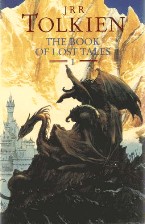 The Book of Lost Tales (1)
The Book of Lost Tales (1)
'The first of a two-book set that contains the early myths and legends which led to the writing of Tolkien's epic tale of war, The Silmarillion. The Book of Lost Tales stands at the beginning of the entire conception of Middle-earth and Valinor for the Tales were the first form of the myths and legends that came to be called The Silmarillion. Embedded in English legend and English association, they are set in the narrative frame of a great westward voyage over the Ocean by a mariner named Eriol to the lonely Isle where the Elves dwelt; from them he learned their true history, the Lost Tales of Elfinesse. In the Tales are found the earliest accounts of Gods and Elves, Dwarves, Balrogs and Orcs; of the Silmarils and the Two Trees of Valinor; of the geography and cosmology of Tolkien's invented world.' (Synopsis from Amazon.co.uk) Buy it! US or UK. 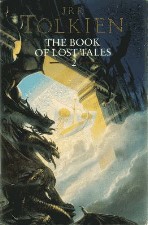 The Book of Lost Tales (2)
The Book of Lost Tales (2)
'The second of a two-book set that contains the early myths and legends which led to the writing of Tolkien's epic tale of war, The Silmarillion. This second part of The Book of Lost Tales includes the tale of Beren and Luthien, Turin and the Dragon, and the only full narratives of the Necklace of the Dwarves and the Fall of Gondolin, itself the finest and most exciting depiction of a battle that Tolkien ever wrote. Each tale is followed by a commentary in the form of a short essay, together with texts of associated poems, and contains extensive information on names and vocabulary in the earliest Elvish languages.' (Synopsis from Amazon.co.uk) Buy it! US or UK. 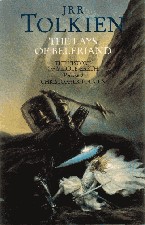 The Lays of Beleriand
The Lays of Beleriand
'The third volume that contains the early myths and legends which led to the writing of Tolkien's epic tale of war, The Silmarillion. This, the third volume of The History of Middle-earth, gives us a priviledged insight into the creation of the mythology of Middle-earth, through the alliterative verse tales of two of the most crucial stories in Tolkien's world -- those of Turien and Luthien. The first of the poems is the unpublished Lay of The Children of Hurin, narrating on a grand scale the tragedy of Turin Turambar. The second is the moving Lay of Leithian, the chief source of the tale of Beren and Luthien in The Silmarillion, telling of the Quest of the Silmaril and the encounter with Morgoth in his subterranean fortress. Accompanying the poems are commentaries on the evolution of the history of the Elder Days. Also included is the notable criticism of The Lay of The Leithian by CS Lewis, who read the poem in 1929.' (Synopsis from Amazon.co.uk) Buy it! US or UK. 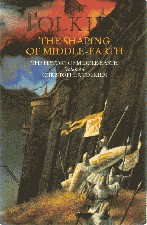 The Shaping of Middle-earth
The Shaping of Middle-earth
'The fourth volume that contains the early myths and legends which led to the writing of Tolkien's epic tale of war, The Silmarillion. In this fourth volume of The History of Middle-earth, the shaping of the chronological and geographical structure of the legends of Middle-earth and Valinor is spread before us. We are introduced to the hitherto unknown Ambarkanta or "Shape of the World", the only account ever given of the nature of the imagined Universe, ccompanied by maps and diagrams of the world before and after the cataclyusms of The War of the Gods and the Downfall of Numenor. The first map of Beleriend is also reproduced and discussed. In The Annals of Valinor and The Annals of Beleriend we are shown how the chronology of the First Age was moulded: and the tale is told of Aelfwine, the Englishman who voyaged into the True West and came to Tol Eressea, Lonely Isle, where he learned the ancient history of Elves and Men. Also included are the original 'Silmarillion' of 1926, and the Quenta Noldorinwa of 1930 -- the only version of the myths and legends of the First Age that J R R Tolkien completed to their end.' (Synopsis from Amazon.co.uk) Buy it! US or UK. 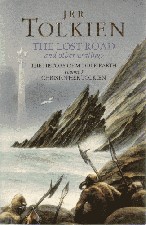 The Lost Road (And Other Writings)
The Lost Road (And Other Writings)
'The fifth volume that contains the early myths and legends which led to the writing of Tolkien's epic tale of war, The Silmarillion. At the end of 1937, J R R Tolkien reluctantly set aside his work on the myths and heroic legends of Valinor and Middle-earth and began The Lord of the Rings. This fifth volume of The History of Middle-earth completes the examination of his writing up to that time. Later forms of The Annals of Valinor and The Annals of Beleriand had been composed, The Silmarillion was nearing completion in a greatly amplified form, and a new Map had been made. The legend of the Downfall of Numenor had entered the work, including those central ideas: the World Made Round and the Straight Path into the vanished West. Closely associated with this was the abandoned 'time-travel' story The Lost Road, linking the world of Numenor and Middle-earth with the legends of many other times and peoples. Also included in this volume is the The Lhammas, as essay on the complex languages and dialects of Middle-earth, and an 'etymological dictionary' containing an extensive account of Elvish vocabularies.' (Synopsis from Amazon.co.uk)Buy it! US or UK. 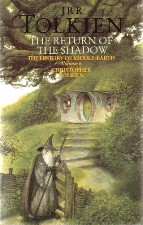 The Return of the Shadow
The Return of the Shadow
'In this sixth volume of "The History of Middle-Earth", Bilbo's "magic ring" becomes evolved into the dangerous Ruling Ring of the Dark Lord and a Black Rider first rides into the Shire. The book comes complete with reproductions of the first maps and facsimile pages from the earliest manuscripts.' (Synopsis from Amazon.co.uk)Buy it! US or UK. 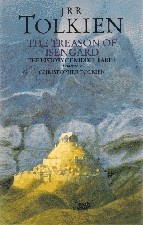 The Treason of Isengard
The Treason of Isengard
'This is the seventh volume of "The History of Middle-earth". The story reaches the beginning of "The Lord of the Rings" and ends at the point where the author halted in the story as the Company of the Ring, still lacking Legolas and Gimli, stood before the tomb of Balin in the Mines of Moria.' (Synopsis from Amazon.co.uk) Buy it! US or UK. |
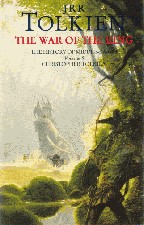 The War of the Ring
The War of the Ring
'In The War of the Ring Christopher Tolkien takes up the story of the writing of The Lord of the Rings with the Battle of Helm's Deep and the drowning of Isengard by the Ents. This is followed by an account of how Frodo, Sam and Gollum were finally brought to the Pass of Kirith Ungol, at which point J.R.R. Tolkien wrote at the time: 'I have got the hero into such a fix that not even an author will be able to extricate him without labour and difficulty'. Then comes the war in Gondor, and the book ends with the parley between Gandalf and the ambassador of the Dark Lord before the Black Gate of Mordor.' (Synopsis from Amazon.com) Buy it! US or UK.  Sauron Defeated
Sauron Defeated
'In the first part of Sauron Defeated, Christopher Tolkien completes his account of the writing of The Lord of the Rings, beginning with Sam's rescue of Frodo from the Tower of Kirith Ungol, and giving a very different account of the Scouring of the Shire. This part ends with versions of the previously unpublished Epilogue, an alternate ending to the masterpiece in which Sam attempts to answer his children's questions years after the departure of Bilbo and Frodo from the Grey Havens. The second part introduces The Notion Club Papers, now published for the first time. Written by J.R.R. Tolkien in the interval between The Two Towers and The Return of the King (1945-1946), these mysterious Papers, discovered in the early years of the twenty-first century, report the discussions of a literary club in Oxford in the years 1986-1987. Those familiar with the Inklings will see a parallel with the group whose members included J.R.R. Tolkien and C.S. Lewis. After a discussion of the possiblities of travel through space and time through the medium of 'true dream," the story turns to the legend of Atlantis, the strange communications received by members of the club out of remote past, and the violent irruption of the legend into northwestern Europe. Closely associated with the Papers is a new version of the Numenorean legend, The Drowning of Anadune, which constitutes the third part of the book. At this time the language of the Men of the West, Adunaic, was first devised - Tolkien's fifteenth invented language. The book concludes with an elaborate account of the structure of this language by Arundel Lowdham, a member of the Notion Club, who learned it in his dreams. Sauron Defeated is illustrated with the changing conceptions of the fortress of Kirith Ungol and Mount Doom, previously unpublished drawings of Orthanc and Dunharrow, and fragments of manuscript written in Numenorean script.' (Synopsis from Amazon.com) Buy it! US or UK. 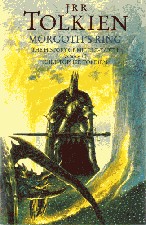 Morgoth's Ring
Morgoth's Ring
'In Morgoth's Ring, the first of two companion volumes, Christopher Tolkien describes and documents the later history of The Silmarillion, from the time when his father turned again to 'the Matter of the Elder Days' after The Lord of the Rings was at last acheived. The text of the Annals of Aman, the 'Blessed Land' in the far West, is given in full; while in writings hitherto unknown is seen the nature of the problems that J.R.R. Tolkien explored in his later years, as new and radical ideas, portending upheaval in the old narratives, emerged at the heart of the mythology, and as the destinies of Men and Elves, mortals and immortals, became of central significance, together with a vastly enlarged perception of the evil of Melkor, the Shadow upon Arda.' (Synopsis from back of book) Buy it! US or UK. 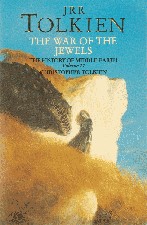 The War of the Jewels
The War of the Jewels
'In volumes ten and eleven of The History of Middle-earth, Christopher Tolkien recounts from the original texts the evolution of his father's work on The Silmarillion, the legendary history of the Elder Days or First Age, from the completion of the Lord of the Rings in 1949 until J.R.R. Tolkien's death. In volume ten, Morgoth's Ring, the narrative was taken only as far as the natural dividing point in the work, when Morgoth destroyed the Trees of Light and fled from Valinor bearing the stolen Silmarils. In The War of the Jewels, the story returns to Middle-earth and the ruinous conflict of the High Elves and the Men who were their allies with the power of the Dark Lord. With the publication in this book of all of J.R.R. Tolkien's later narrative writing concerned with the last centuries of the First Age, the long history of The Silmarillion, from its beginnings in The Book of Lost Tales, is completed; the enigmatic state of the work at his death can now be understood. A chief element in The War of the Jewels is a major story of Middle-earth, now published for the first time - a continuation of the great "saga" of Turin Turambar and his sister Nienor, the children of Hurin the Steadfast. This is the tale of the disaster that overtook the forest people of Brethil when Hurin came among them after his release from long years of captivity in Angband, the fortress of Morgoth. The uncompleted text of the Grey Annals, the primary record of the War of the Jewels, is given in full; the geography of Beleriand is studied in detail, with redrawings of the final state of the map; and a long essay on the names and relations of all the peoples of Middle-earth shows more clearly than any writing yet published the close connection between the language and history in Tolkien's world. The text also provides new information, including some knowledge of the divine powers, the Valar.' (Synopsis from Amazon.com) Buy it! US or UK. 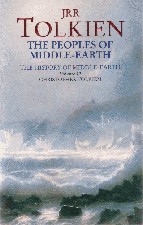 The Peoples of Middle Earth
The Peoples of Middle Earth
'Throughout this vast and intricate mythology, says Publishers Weekly, "one marvels anew at the depth, breadth, and persistence of J.R.R. Tolkien's labor. No one sympathetic to his aims, the invention of a secondary universe, will want to miss this chance to be present at the creation." In this capstone to that creation, we find the chronology of Middle-earth's later Ages, the Hobbit genealogies, and the Western language or Common Speech. These early essays show that Tolkien's fertile imagination was at work on Middle-earth's Second and Third Ages long before he explored them in the Appendices to The Lord of the Rings . Here too are valuable writings from Tolkien's last years: " The New Shadow," in Gondor of the Fourth Age, and" Tal-elmar," the tale of the coming of the Numenorean ships.' (Synopsis from Amazon.com) Buy it! US or UK. Book covers by John Howe Back to Booklist |
Last updated 21-7-09.